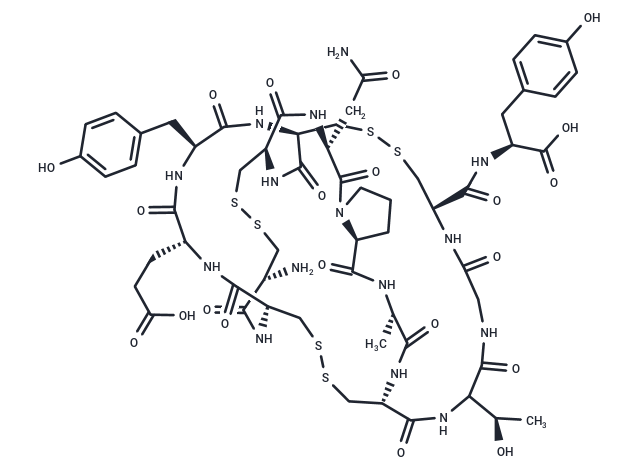Shopping Cart
Remove All Your shopping cart is currently empty
Your shopping cart is currently empty
Linaclotide, developed for the treatment of constipation-predominant irritable bowel syndrome (IBS-C) and chronic constipation, is a potent and selective guanylate cyclase C agonist.

| Pack Size | Price | USA Warehouse | Global Warehouse | Quantity |
|---|---|---|---|---|
| 1 mg | $45 | In Stock | In Stock | |
| 5 mg | $106 | In Stock | In Stock | |
| 10 mg | $197 | In Stock | In Stock | |
| 25 mg | $347 | In Stock | In Stock | |
| 50 mg | $516 | In Stock | In Stock | |
| 100 mg | $736 | In Stock | In Stock | |
| 200 mg | $987 | - | In Stock | |
| 1 mL x 10 mM (in DMSO) | $283 | In Stock | In Stock |
| Description | Linaclotide, developed for the treatment of constipation-predominant irritable bowel syndrome (IBS-C) and chronic constipation, is a potent and selective guanylate cyclase C agonist. |
| In vitro | Linaclotide acts on guanylate cyclase-C receptors on the luminal membrane to increase chloride and bicarbonate secretions into the intestine, inhibit sodium ion absorption, enhance water secretion into the lumen, and improve defecation; the drug is minimally absorbed into the systemic circulation[2]. In vitro, linaclotide inhibits [125I]-STa binding to intestinal mucosal membranes from wt mice in a concentration-dependent manner, while binding to membranes from GC-C null mice significantly decreases. Linaclotide is completely degraded after a 30-minute incubation in jejunal fluid in vitro[1]. |
| In vivo | Linaclotide significantly increases weekly spontaneous bowel movements and complete spontaneous bowel movements (CSBMs) while reducing abdominal pain in patients with chronic constipation [2]. Pharmacokinetic analysis shows very low oral bioavailability (0.10%). In intestinal secretion and transit models, linaclotide exhibits significant pharmacological effects in wt, but not in GC-C null mice: increased fluid secretion into surgically ligated jejunal loops is accompanied by elevated cyclic guanosine-3',5-monophosphate levels and accelerated gastrointestinal transit [1]. |
| Molecular Weight | 1526.74 |
| Formula | C59H79N15O21S6 |
| Cas No. | 851199-59-2 |
| Smiles | C[C@@H](O)C1NC(=O)[C@@H]2CSSC[C@@H]3NC(=O)[C@@H](N)CSSC[C@H](NC(=O)[C@H](CSSC[C@H](NC(=O)CNC1=O)C(=O)N[C@@H](Cc1ccc(O)cc1)C(O)=O)NC(=O)[C@H](Cc1ccc(O)cc1)NC(=O)[C@@H](CCC(O)=O)NC3=O)C(=O)N[C@@H](CC(N)=O)C(=O)N1CCC[C@H]1C(=O)N[C@@H](C)C(=O)N2 |
| Relative Density. | 1.60 g/cm3 |
| Storage | keep away from moisture | Powder: -20°C for 3 years | In solvent: -80°C for 1 year | Shipping with blue ice/Shipping at ambient temperature. | ||||||||||||||||||||
| Solubility Information | H2O: 20 mg/mL (13.1 mM), Sonication is recommended. | ||||||||||||||||||||
| In Vivo Formulation | 10% DMSO+40% PEG300+5% Tween 80+45% Saline: 2 mg/mL (1.31 mM), Sonication is recommended. Please add the solvents sequentially, clarifying the solution as much as possible before adding the next one. Dissolve by heating and/or sonication if necessary. Working solution is recommended to be prepared and used immediately. The formulation provided above is for reference purposes only. In vivo formulations may vary and should be modified based on specific experimental conditions. | ||||||||||||||||||||
Solution Preparation Table | |||||||||||||||||||||
H2O
| |||||||||||||||||||||
| Size | Quantity | Unit Price | Amount | Operation |
|---|

Copyright © 2015-2025 TargetMol Chemicals Inc. All Rights Reserved.